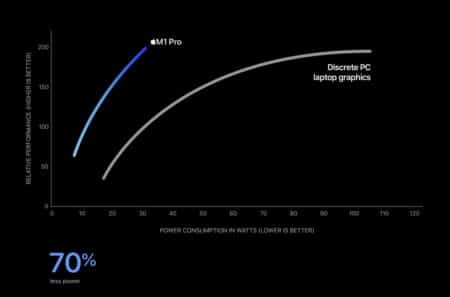Continued from page 1
The Numbers
The new MacBook Pro showed up on Geekbench on Monday with results. Its Geekbench 5 results notched a score of 11,542, which blows away the M1-based Mac mini results we tested and posted at 7,675, a definitive 150 percent improvement.
And on single-core tests, the 10-core M1 Max-based MacBook notched a score of 1,749. Our M1 mini actually yielded 1,748 but averages are a bit lower. Essentially, the new M1 Pro and M1 Max are nearly identical in single-core performance with slight improvements over the M1. But their single-core performance is only bested by Intel Core i9 11900K and 11900KF 8-core processors. And only by about 5.8 percent for the first of those chips noted above.

The M1 Pro consumes 70 percent less power at its peak than a PC laptop with a discrete GPU. (Image: Apple)
These new MacBook Pros are essentially at the top of the single-core performance heap and now at the top of the heap on multi-core performance. And they achieve this performance with stunningly low energy needs compared to rival processors.
New MacBook Pros
The new MacBook Pros come in 14-in. and 16-in. versions. Either machine would be excellent for CAD/BIM/3D professionals with mobile workflows. They essentially are tied with AMD and Intel’s best CPUs for the fastest single-core processing in existence. So programs like Revit or SketchUp, which are mostly single-threaded, will do very well. And they match the very best in discreet mobile GPUs at 70 percent less power.
Architosh Analysis and Commentary
We published an analysis the night before the event and got it wrong on Apple’s “chiplet” technology. Apple isn’t going to chiplet packaging quite yet, and we have no real proof they will ultimately go there. However, other parts of our analysis are mostly correct. In particular, references to Bloomberg’s Mark Gurman’s Jade C-Chop and Jade C-Die seem spot on in terms of the potential meaning of those words. As Anandtech noted yesterday about the “peculiar” way the whole top of the M1 Pro looks like the M1 Max, we think that they are identical in every way because the M1 Pro may be a “chopped down” version of the M1 Max. (see: Architosh, “Apple’s new M1 Pro is ‘Chop’ version of M1 Max Die (?),” 18 Oct 21)
The question then becomes, what would Apple do with the chopped-off piece, which consists of 16 GPU cores, 2 SLCs, and 2 memory interfaces? There also seems to be a 16 core Neural Engine section on the lower part of the die that matches the upper part. If the M1 Pro’s code name was Jade C-Chop as Gurman wrote in his Bloomberg report, it implies that chip is not the full die but rather a chopped down version of the full die. Jade C-Max means more than just maximum performance but the max area of the chip die itself.
A literal cut or chop would mean massive wafer waste and tons of inefficiency, that could only be made up if Apple could reuse the chopped section in future chiplet design packaging. The codename Jade C-Chop may not be literal but imply a digital chop line as in the architectural floorplan for the M1 Pro and that it is identical to the M1 Max except that the lower part is removed. But the word “chop” seems strange if it is only digital. Perhaps Mark Gurman’s codenames for the M1 Pro and M1 Max were old or wrong?
Still, if Apple is going to a chiplet design for 20 and 40 core SoCs in the big iMac and Mac Pro, these chopped-off 16 core GPU sections complete with Neural Engines, memory interfaces, and SLCs could be discrete components on an interposer layer in a chiplet package. If this idea sounds crazy to you, share your thoughts below in our new Disqus-powered Comments section.




Reader Comments
Comments for this story are closed